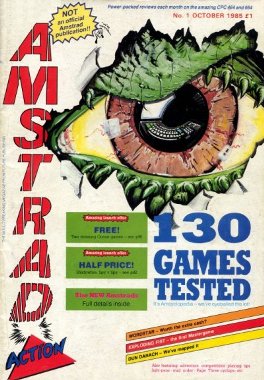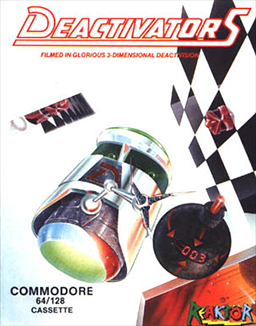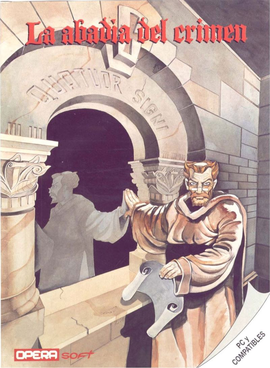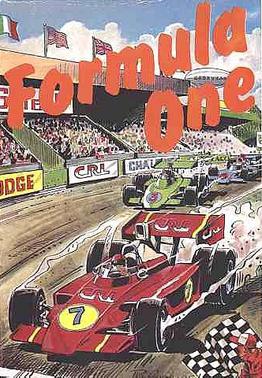
The Amstrad CPC is a series of 8-bit home computers produced by Amstrad between 1984 and 1990. It was designed to compete in the mid-1980s home computer market dominated by the Commodore 64 and the ZX Spectrum, where it successfully established itself primarily in the United Kingdom, France, Spain, and the German-speaking parts of Europe.

Amstrad was a British consumer electronics company, founded in 1968 by Alan Sugar. During the 1980s, the company was known for its home computers beginning with the Amstrad CPC and later also the ZX Spectrum range after the Sinclair deal, which led it to have a substantial share of the PC market in Britain. In the following decade it shifted focus towards communication technologies, and its main business during the 2000s was the manufacture of satellite television set-top boxes for Sky, which Amstrad had started in 1989 as the then sole supplier of the emerging Sky TV service.

Amstrad Action was a monthly magazine, published in the United Kingdom, which catered to owners of home computers from the Amstrad CPC range and later the GX4000 console.

The CPC 464 is the first personal home computer built by Amstrad in 1984. It was one of the bestselling and best produced microcomputers, with more than 2 million units sold in Europe. The British home computer boom had already peaked before Amstrad announced the CPC 464 which they then released a mere nine months later.
Andrew Nicholas Oliver and Philip Edward Oliver, together known as the Oliver Twins, are British twin brothers and video game designers.

Locomotive Basic is a proprietary dialect of the BASIC programming language written by Locomotive Software on the Amstrad CPC and the later Locomotive BASIC-2 as a GEM application on the Amstrad PC1512 and 1640. It was the main descendant of Mallard BASIC, the interpreter for CP/M supplied with the Amstrad PCW.
Newsfield Publications Ltd was a British magazine publisher during the 1980s and early 1990s.
Locomotive Software was a small British software house that did most of its development for Amstrad's home and small business computers of the 1980s. It was founded by Richard Clayton and Chris Hall on 14 February 1983.

The GX4000 is a video game console that was manufactured by Amstrad. It was the company's short-lived attempt to enter the games console market. The console was released in Europe in 1990 and was an upgraded design based on the then still-popular CPC technology. The GX4000 shared hardware architecture with Amstrad's CPC Plus computer line, which was released concurrently. This allowed the system to be compatible with the majority of CPC Plus software.
AMSDOS is a disk operating system for the 8-bit Amstrad CPC Computer. The name is a contraction of Amstrad Disk Operating System.

Amstrad Computer User was the official magazine for the Amstrad CPC series of 8-bit home computers. This monthly publication, usually referred to as ACU by its readers, concentrated more on the hardware and technical side of the Amstrad range, although it had a small dedicated games section as well.
Amsoft was a wholly owned subsidiary of Amstrad, PLC, founded in 1984 and re-integrated with its parent company in 1989. Its purpose was to provide an initial infrastructure of software and services for users of Amstrad's range of home computers, the Amstrad CPC and, from 1986, the ZX Spectrum. Many people's first contact with software on an Amstrad home computer would have been an Amsoft title, as several titles were included in the sales bundles.

Oh Mummy is a video game for the Amstrad CPC models of home computer. It was developed by Gem Software and published by Amsoft in 1984. It was often included in the free bundles of software that came with the computer. The gameplay is similar to that of the 1981 arcade game Amidar.

Deactivators is a 1986 puzzle video game designed by David Bishop and Chris Palmer, developed by Tigress Marketing and System Software, and published by Ariolasoft's action game imprint Reaktor. The player controls bomb disposal robots known as deactivators and must use them to deactivate bombs planted by terrorists in five research complexes. The concept for the game came from a brainstorming session between Bishop and Palmer; its design and development took five to six months to complete. It was released for the Amstrad CPC 464, Commodore 64, and ZX Spectrum platforms in October 1986.

La abadía del crimen is a video game written by Paco Menéndez with graphics made by Juan Delcán and published in 1987 by Opera Soft. It was conceived as a version of Umberto Eco's 1980 book The Name of the Rose. Paco Menéndez and Opera Soft were unable to secure the rights for the name, so the game was released as La abadía del crimen. "The Abbey of the Crime" was the working title of the novel The Name of the Rose.

Formula One is a Formula One racing management video game published in 1985 by CRL Group PLC. It was developed by G.B. Munday and B.P. Wheelhouse for the ZX Spectrum, and converted to Amstrad CPC by Richard Taylor.
Tiertex Design Studios Limited was a British software development company and former video game developer based in Macclesfield, England; it was founded in 1986, focusing on porting games to home computers and handheld platforms.

Roland Goes Digging is a 1984 computer game for the Amstrad CPC series of home computers. It was distributed by Amsoft, on cassette tape for CPC 464 and Amstrad's proprietary 3" disk format, for CPC 664 and CPC 6128 users. The game was developed by regular Amsoft contributors Gem Software and featured Amstrad's CPC mascot Roland, who also appears in other games in the Roland series, such as Roland in the Caves, Roland in Time and Roland in Space.
The Amstrad CPC character set is the character set used in the Amstrad CPC series of 8-bit personal computers when running BASIC. This character set existed in the built-in "lower" ROM chip. It is based on ASCII-1967, with the exception of character 0x5E which is the up arrow instead of the circumflex, as it is in ASCII-1963, a feature shared with other character sets of the time. Apart from the standard printable ASCII range (0x20-0x7e), it is completely different from the Amstrad CP/M Plus character set. The BASIC character set had symbols of particular use in games and home computing, while the CP/M Plus character reflected the International and Business flavor of the CP/M Plus environment. This character set is represented in Unicode as of the March 2020 release of Unicode 13.0, which added symbols for legacy computing. The three missing characters have however been accepted for inclusion in Unicode 16.0 in the symbols for legacy computing supplement.












